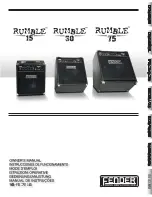
2.4
Commands
2 – 5
2.4
Commands
This section provides syntax and operational descriptions for remote
commands.
2.4.1
Command syntax
The four letter mnemonic (shown in
CAPS
) in each command se-
quence specifies the command. The rest of the sequence consists of
parameters.
Commands may take either
set
or
query
form, depending on whether
the “
?
” character follows the mnemonic.
Set only
commands are
listed without the “
?
”,
query only
commands show the “
?
” after the
mnemonic, and
optionally query
commands are marked with a “
(?)
”.
Parameters shown in
{ }
are not always required. Parameters in
{ }
are required to set a value, and are omitted for queries. Parameters
listed without any surrounding characters are always required.
Do
not
send ( ) or
{ }
as part of the command.
Multiple parameters are separated by commas. Commands are ter-
minated by either
h
CR
i
or
h
LF
i
characters. Null commands and
whitespace are ignored. Execution of command(s) does not begin
until the command terminator is received.
2.4.2
Notation
The following table summarizes the notation used in the command
descriptions:
symbol
definition
i
Integers
(
?
)
Required for queries; illegal for set commands
{
var
}
required parameter for set commands; illegal for queries
2.4.3
Examples
Each command is provided with a simple example illustrating its
usage. In these examples, all data sent by the host computer to
the SIM910 are set as
straight teletype font
, while responses
received the host computer from the SIM910 are set as
slanted
teletype font
.
SIM910
JFET Preamp













































